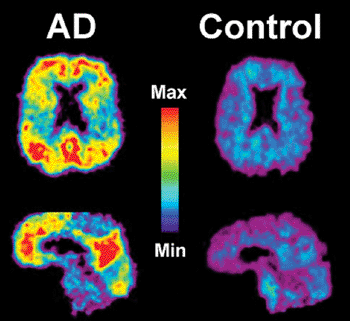Serum Cholesterol Levels Linked to Cerebral Amyloidosis
By LabMedica International staff writers
Posted on 15 Jan 2014
The relationship between elevated cholesterol and increased risk of Alzheimer’s disease has been specifically linked to amyloid deposits in living human study participants.Posted on 15 Jan 2014
Higher levels of high-density lipoprotein cholesterol (HDL-C) and lower levels of low-density lipoprotein cholesterol (LDL-C) in the bloodstream are associated with lower levels of cerebral β-amyloid (Aβ) plaque deposits in the brain.

Image: Pittsburgh Compound B (PiB) positron emission tomography scan of a patient with Alzheimer\'s disease (AD) on the left; red and yellow show high concentrations of PiB in the brain and suggest high amounts of amyloid deposits in these areas (Photo courtesy of the University of Pittsburgh).
Scientists at the University of California, (Davis, CA, USA) recruited 74 men and women aged 70 and over who were attending the Alzheimer's Disease Center, stroke clinics, and community senior facilities. The group included 3 people with mild dementia, 38 with mild cognitive impairment, and 33 who were cognitively normal. All the participants had fasting blood tests and cerebral Aβ, was measured with carbon 11C–labeled Pittsburgh Compound B (PIB) positron emission tomography where amyloid plaques were highlighted using a radioactive tracer that binds to them.
Elevated cerebral Aβ level was associated with cholesterol fractions in a pattern analogous to that found in coronary artery disease. The investigators found that higher levels of LDL cholesterol and lower levels of HDL cholesterol were linked to more amyloid plaques in the brain. The findings were independent of age or presence of the E4 variant of the apolipoprotein E (ApoE) gene, which has been linked to some forms of Alzheimer's. The mean fasting total cholesterol level for the group was 171 mg/dL, and mean levels for the LDL-C and HDL-C were 92 and 54 mg/dL, respectively.
Bruce Reed, PhD, the lead author said, “This study provides a reason to certainly continue cholesterol treatment in people who are developing memory loss, regardless of concerns regarding their cardiovascular health. It also suggests a method of lowering amyloid levels in people who are middle aged, when such build-up is just starting. If modifying cholesterol levels in the brain early in life turns out to reduce amyloid deposits late in life, we could potentially make a significant difference in reducing the prevalence of Alzheimer’s, a goal of an enormous amount of research and drug development effort.” The study was published on December 30, 2013, in the journal JAMA Neurology.
Related Links:
University of California Davis














